11 Conifers and Palms for Windy Locations
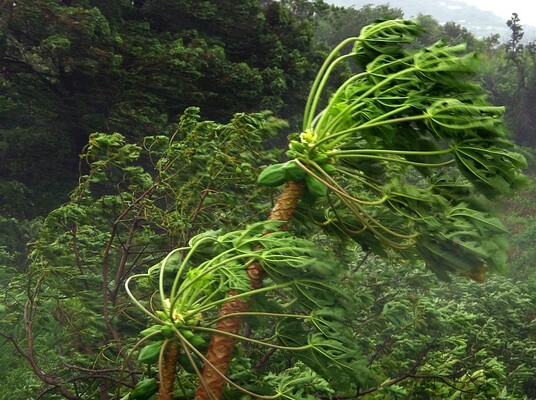
Introduction
Previously, we discussed the importance of selecting wind-tolerant hardwood tree species for those living in windswept areas such as San Francisco and the Bay Area. These regions are particularly affected by the aptly named “Diablo Winds.” In this article, we will explore a few palms and conifers that thrive in windy conditions.
Fern Pines
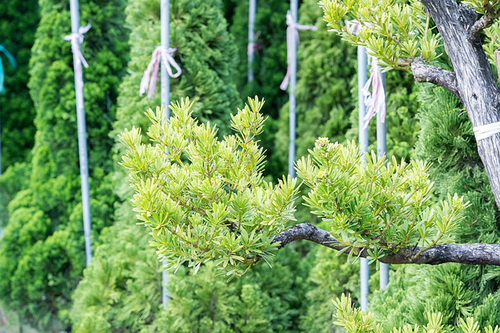
The Branch of a Fern Pine
Fern pines (Podocarpus spp.) are a genus of evergreen conifers primarily native to the Southern Hemisphere. Several of the 100-or-so species in the genus are commonly planted as street, shade, or ornamental trees. These trees possess strong wood and structure, enabling them to withstand high winds. Many songbirds feed upon the fleshy cones of fern pines, further enhancing the tree’s appeal and ecological value. Their resilience and attractiveness make them a great choice for windy locations.
Fern pines are also valued for their dense foliage, which provides excellent shade and privacy. They are relatively low-maintenance and can thrive in a variety of soil conditions, making them a versatile choice for urban and suburban landscapes.
Cabbage Palm
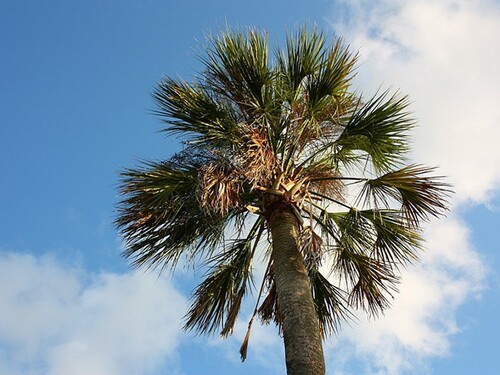
A Cabbage Palm Standing Tall
Cabbage or sabal palms (Sabal palmetto) , the state tree of both South Carolina and Florida, are ideal for elevated seaside planting locations due to their tolerance of salt spray. However, they do not thrive in salt-laden soils. Cabbage palms resist most pests and withstand high wind speeds with minimal trouble. Special care is required during the transplantation process as the trees form new root systems. Once established, they are low-maintenance and resilient.
These palms are also known for their attractive fan-shaped leaves and tall, slender trunks. They can grow up to sixty-five feet tall and are often used in coastal landscaping for their aesthetic appeal and ability to withstand harsh weather conditions.
Jelly Palm
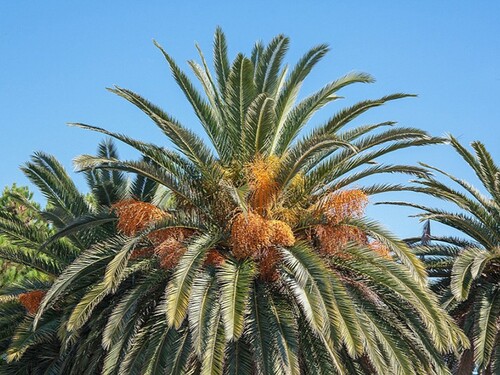
A Jelly Palm Loaded with Fruit
The thick trunks of jelly palms (Butia capitata) helps these stout trees survive the strong winds common to the Bay Area and other coastal locations. They are known for their hardiness, particularly in terms of cold tolerance, surviving temperatures as low as 14 degrees Fahrenheit (-10 degrees Celsius). Jelly palms require abundant sunlight to thrive. Their resilience and low maintenance make them a practical choice for windy coastal areas.
In addition to their wind and cold tolerance, jelly palms are appreciated for their ornamental value. They produce small, edible fruits that have a sweet, jelly-like texture and can be used in various culinary applications.
Date Palm
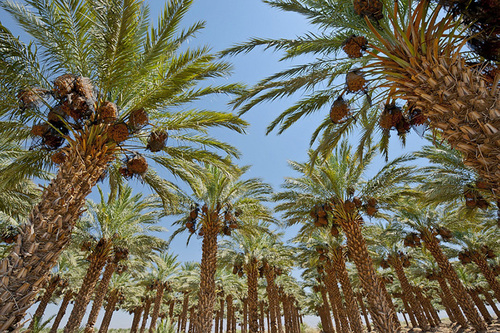
Rows of Date Palms in an Orchard
Date palms (Phoenix dactylifera) are large, impressive trees, often reaching seventy-five feet or more in height. A variety of date palm cultivars are available commercially, including those used for date production. Date palms are dioecious plants, meaning individuals are either male or female. If you are interested in producing fruit, you must obtain both male and female specimens. Their impressive size and fruit-bearing capability make them a valuable addition to any landscape.
Date palms are also known for their distinctive appearance, with long, arching fronds and a sturdy trunk. They require full sun and well-drained soil to thrive and can live for over one hundred years, making them a long-term investment for your landscape.
Bald Cypress
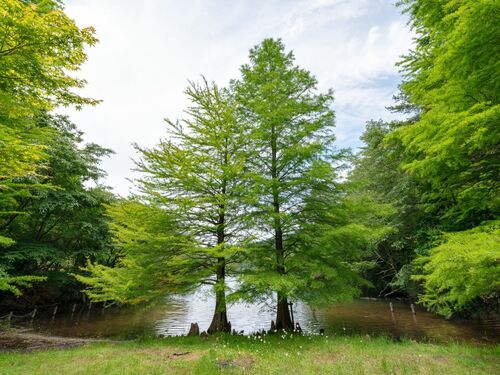
Bald Cypress Trees Next to a Pond
Bald cypresses (Taxodium distichum) are a quintessential species of southern swamps and bayous. These habitats are often subjected to hurricanes, forcing these long-lived trees to adapt to high winds. The primary challenges to maintaining cypress trees are their thirsty nature and immense size, as they may reach 120 feet in height. However, their close relative, the pond cypress (Taxodium ascendens) , is equally resistant to high winds and might be more manageable for smaller yards.
Bald cypresses are also notable for their unique root structures, known as "knees," which protrude from the ground around the tree. These knees help stabilize the tree in wet, swampy conditions and add a distinctive look to your landscape.
Canary Island Pine
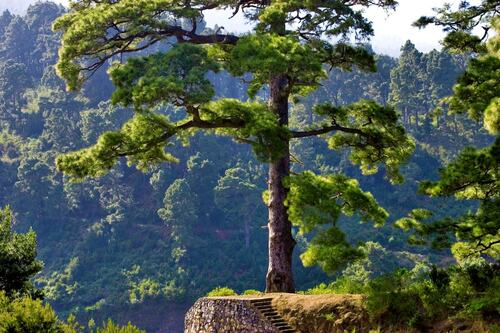
A Lone Canary Island Pine Tree
Canary Island pines (Pinus canariensis) are known for their tall, straight trunks and ability to withstand strong winds. Native to the Canary Islands, these trees are well suited to coastal and windy environments. These pines are drought tolerant and can grow in a variety of soil types. Their resilience and height make them excellent windbreaks.
Canary Island pines also have attractive dark-green needles and produce large ornamental cones. They can grow up to eighty feet tall and are often used in parks and large gardens for their impressive stature and wind resistance.
Aleppo Pine
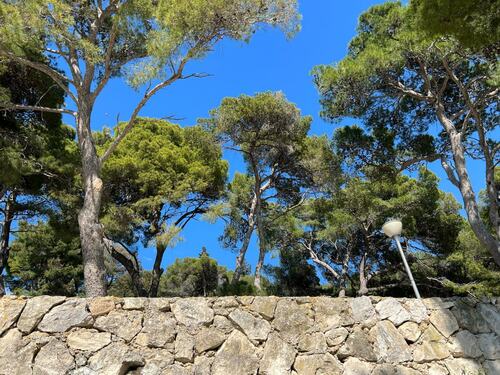
A Group of Aleppo Pines Above a Retaining Wall
Aleppo pines (Pinus halepensis) are native to the Mediterranean region and are highly adaptable to dry, windy conditions. They are fast growing and can reach up to sixty feet in height. Aleppo pines are resistant to drought and poor soil conditions. They provide excellent shade and wind protection, making them ideal for windy locations.
These pines are also valued for their picturesque, irregular shape and grey-green foliage. They are often used in reforestation projects and as ornamental trees in gardens and urban areas.
Windmill Palm
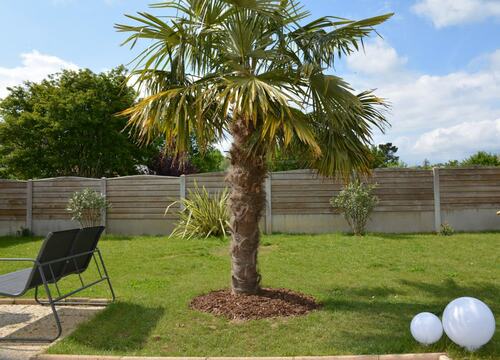
A Windmill Palm in a Backyard
Windmill palms (Trachycarpus fortunei) are hardy palms that can withstand both cold temperatures and high winds. They are often used in landscaping for their distinctive fan-shaped leaves. These palms are relatively low-maintenance and can tolerate a variety of soil types. Their hardiness and unique appearance make them a popular choice for coastal and windy areas.
Windmill palms are also known for their slender, fibrous trunks, which add an exotic look to gardens and landscapes. They can grow up to forty feet tall and are particularly suited to cooler climates compared to other palm species.
Monterey Pine
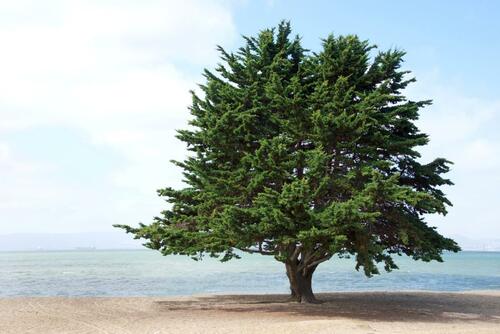
A Monterey Pine Grows on a Northern California Beach
Monterey pines (Pinus radiata) are native to the coastal regions of California and are known for their rapid growth and ability to withstand windy conditions. Monterey pines are highly adaptable and can grow in a variety of soil types. Their fast growth and wind tolerance make them a great choice for windbreaks and coastal landscapes.
Monterey pines are also appreciated for their dense dark-green foliage and ability to provide excellent shade. They can grow up to one hundred feet tall and are often used in reforestation efforts and as ornamental trees in large gardens and parks.
Mexican Fan Palm

A Group of Mexican Fan Palm Trees
Mexican fan palms (Washingtonia robusta) are tall, slender palms that can reach up to one hundred feet in height. They are well suited to coastal areas and can withstand high winds. These palms are drought tolerant and require minimal maintenance. Their impressive height and wind tolerance make them a popular choice for coastal and windy locations.
In addition to their wind resistance, Mexican fan palms are known for their striking appearance, with long, fan-shaped leaves and a tall, straight trunk. They are often used in urban landscaping and can create a dramatic tropical look in any setting.
Norfolk Island Pine
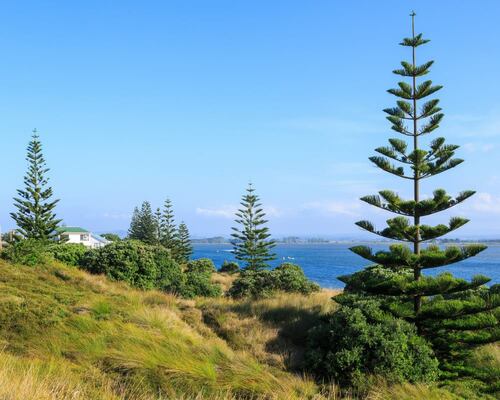
A Hillside Dotted with Norfolk Island Pines
Norfolk Island pines (Araucaria heterophylla) are native to the South Pacific and are known for their symmetrical, triangular shape and ability to withstand windy conditions. These pines are salt tolerant and can grow in a variety of soil types. Their unique shape and resilience make them an attractive addition to coastal and windy landscapes.
Norfolk Island pines also make excellent indoor plants when young due to their attractive tiered branches and soft, green needles. They can grow up to two hundred feet tall in their natural habitat, making them striking feature trees for large gardens and parks.
Conclusion
We hope you consider these suggestions when adding new trees to your property. Whether you need residential tree pruning in San Francisco or commercial tree services in Millbrae, Arborist Now is here to help keep your trees happy, healthy, and looking their best. Contact us for advice and help with planting wind-resistant trees that can weather any storm!
Originally posted on June 3, 2021.





